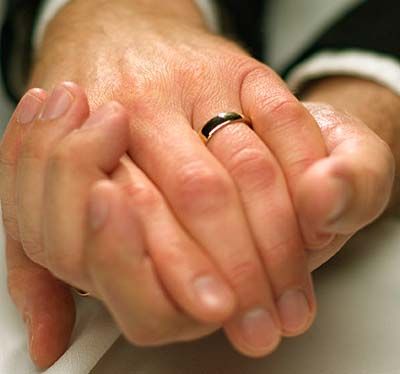 Of course it's a theological issue, and one that is ultimately sacramental in nature. However, my original point was that in western media at least, there is a distinction made between civil unions and marriage whenever this is discussed. "Full inclusion in the life of the church" is also mentioned a lot -- so, I'm curious to know how it is that civil unions are a practice of the church, for sure. But I'm also certain that no one in the western church, or not a lot of people, are really talking about developing gay marriage ceremonies, but rather same-sex-union ceremonies. Here's a recent article that sort of deals with it.
Posted by Micah Weedman at 8:23 am on July 4, 2006
Of course it's a theological issue, and one that is ultimately sacramental in nature. However, my original point was that in western media at least, there is a distinction made between civil unions and marriage whenever this is discussed. "Full inclusion in the life of the church" is also mentioned a lot -- so, I'm curious to know how it is that civil unions are a practice of the church, for sure. But I'm also certain that no one in the western church, or not a lot of people, are really talking about developing gay marriage ceremonies, but rather same-sex-union ceremonies. Here's a recent article that sort of deals with it.
Posted by Micah Weedman at 8:23 am on July 4, 2006
There can be a reality called "same-sex unions" in the secular marketplace and then another reality called "marriage," but it is hard to draw these lines in the ancient doctrines of the Christian faith. As the Archbishop of Canterbury noted in his letter to the primates, the key theological issue is what relationships can be blessed or called sacraments and what relationships cannot.
Postmodern people may be able to say that you can create a new liturgical rite to bless same-sex relationships without affecting the status of the ancient Sacrament of Marriage, but premodern people in Rome, the East and conservative Anglicanism are going to reject that equation.
And what if the same-sex rites are clearly meant to take the place of marriage rites or to substitute for them? This is why it is so important that (a) the Episcopal Church's liberal establishment is doing so much of this liturgical experimentation at the local level away from major media coverage and (b) that the media realize that the same-sex liturgies are just as important, or more important, than the issue of one or two episcopal elections. Again, read what Archbishop Rowan Williams wrote on that issue.
I also dug into this a bit several years ago in a Scripps Howard column on the trial rites. Click here to see that column. Here is how it started:
The couple holds hands before the altar as a priest guides them through their vows.
"I take you to have and to hold from this day forward, to love and to cherish, for better or for worse, in sickness and in health, as my companion, lover and friend."
The congregation responds: "Blessed be God who appears to us in their love."
There is the exchanging of rings, familiar scriptures, a kiss and a blessing on the couple's "acts of tenderness and intimacy." They may be crowned or anointed before Holy Communion. The priest may lead them in a procession around the altar, cover them with a veil or tie their hands with a cord.
This is not a wedding.
Nevertheless, "A Rite for the Celebration of Commitment to a Life Together" features a barrage of symbols from centuries of marriage rites. This 1996 text is an American example of the same-sex union rites that are shaking the 70-million-member Anglican Communion.
"This rite is clearly parasitic on marriage," said Edith Humphrey, a Canadian Anglican who teaches at Pittsburgh Theological Seminary. "At least this American rite is in your face, so you know what is being communicated. That kind of candor is refreshing. ... This certainly looks like a marriage rite."
But does that make this rite a sacramental statement, a kind of non-marriage marriage that makes the sacramental claims of a marriage? Read on.
